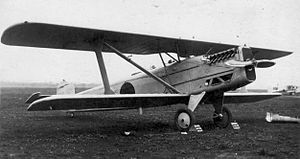Kawasaki Army Type 88 Reconnaissance Aircraft: Difference between revisions
+image |
m replace |
||
| Line 2: | Line 2: | ||
{|{{Infobox Aircraft Begin |
{|{{Infobox Aircraft Begin |
||
|name=KDA-2 (Type 88) |
|name=KDA-2 (Type 88) |
||
|image=File: |
|image=File:88shiki teisatuki.jpg |
||
|caption= |
|caption= |
||
}}{{Infobox Aircraft Type |
}}{{Infobox Aircraft Type |
||
Revision as of 14:37, 31 December 2010
| KDA-2 (Type 88) | |
|---|---|

| |
| Role | Reconnaissance biplane and light bomber |
| Manufacturer | Kawasaki |
| Designer | Richard Vogt[1] |
| First flight | 1927 |
| Primary user | Imperial Japanese Army Air Force |
| Produced | 1929-1932 |
| Number built | 1117 |
The Kawasaki KDA-2 was a Japanese single-engined biplane of the late 1920s designed by the German Richard Vogt working for Kawasaki. It was built in large numbers as both a reconnaissance aircraft and a light bomber for the Imperial Japanese Army, being used in combat over China and remaining in service until 1940.
Design and development
The KDA-2 was designed by Richard Vogt to meet a Japanese Army requirement for a reconnaissance biplane to replace the Salmson 2. Three prototypes were built by Kawasaki in 1927. Following testing the aircraft was ordered into production as the Army Type 88-1 Reconnaissance Biplane. The aircraft was of all-metal construction, with a stressed skin forward fuselage, had unequal-span wings and a slim angular fuselage, cross-axle tailwheel landing gear and was powered by a 447 kW (600 hp) BMW VI engine. An improved version (the Type 88-II) was developed with an improved engine cowling and a revised tail unit. By the end of 1931, a total of 710 (including the three prototypes) had been built by both Kawasaki and Tachikawa (187 of the total).[2]
Between 1929 and 1932, a bomber version was built as the Type 88 Light Bomber, differing in having a strengthened lower wing and an additional pair of centre-section struts. Bomb racks were located under the fuselage and lower wings. A total of 407 were produced.[3] A transport variant was developed as the KDC-2 with room for a pilot and four passengers in an enclosed cabin. Only two KDC-2s were built and one of was tested on floats.[4]
Operational history
Both reconnaissance and bomber versions saw action with the Imperial Japanese Army Air Force in Manchuria, and a few were still in service in 1937 during fighting at Shanghai.
Variants
- KDA-2
- Three prototypes.
- Type 88-I Reconnaissance Biplane
- Production reconnaissance biplane.
- Type 88-II Reconnaissance Biplane
- Improved version of the 88-I, 707 built of both the 88-I and 88-II.
- Type 88 Light Bomber
- Light bomber variant able to carry 200 kg (440 lb) of bombs, 407 built.
- KDC-2
- Transport variant, two built.
Operators
Specifications (88-II)
Data from Japanese Aircraft 1910-1941 [5]The Illustrated Encyclopedia of Aircraft (Part Work 1982-1985). Orbis Publishing. p. 2238. {{cite book}}: Cite has empty unknown parameter: |coauthors= (help)
General characteristics
- Crew: 2
Performance
Notes
References
- The Illustrated Encyclopedia of Aircraft (Part Work 1982-1985). Orbis Publishing. pp. 2237–8.
{{cite book}}: Cite has empty unknown parameter:|coauthors=(help) - Mikesh, Robert C (1990). Japanese Aircraft 1910-1941. London: Putnam. ISBN 0 85177 840 2.
{{cite book}}: Unknown parameter|coauthors=ignored (|author=suggested) (help)
